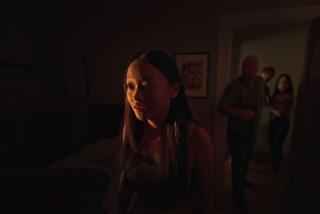Review: What’s scary about ‘The Other Side of the Door’ is its stereotypes
- Share via
For a movie whose very title promises revelation, the Mumbai-set, India-denigrating “The Other Side of the Door” — about the pitfalls of laying out a welcome mat for ghosts — is drearily content with disclosing little more than a spread of supernatural horror movie clichés both warmed-over and culturally cheap.
Six years after choosing to settle in India and start a family, antiques dealer Michael (Jeremy Sisto) and wife Maria (Sarah Wayne Callies) find themselves the grieving parents of a son named Oliver (Logan Creran) who perished in a drowning accident that Maria and their daughter Lucy (Sofia Rosinsky) survived. (It’s a suitably intense flashback.)
SIGN UP for the free Indie Focus movies newsletter >>
When their epically brow-furrowed, filmed-in-half-shadow housekeeper Piki (Suchitra Pillai-Malik) informs Maria that an abandoned temple in her home village contains a thin barrier between the worlds of the living and the dead, mom secretly makes the trip, initiating contact with her deceased son’s voice through the thick temple entrance. She also does the one thing Piki warned her not to do — open said door during contact. But, hey, there’d be no movie otherwise.
There’s still no movie otherwise. “The Other Side of the Door” is almost unsurpassingly dull and frightless. Balancing mood and payoff in the haunted house genre is tricky, but director/co-writer Johannes Roberts checks off the tropes — fake shocks, moving furniture, spooky stuffed animal, the piano that plays by itself, possessed children — with all the excitement of a bored Realtor.
SIGN UP for the free Classic Hollywood newsletter >>
The under-imagined, haphazardly calibrated roles suffer even more as a result: Callies struggles to marry a thoughtful portrait of suffering to the predictable junkiness around her, while Sisto is absent for such extended stretches he’s a nonpresence. Roberts can’t even wrest creepy-kid turns out of his young performers, and they’re a dime a dozen in the horror world.
Then there’s the anthropologically exploitative use of a real Hindu sect of graveyard lurkers known as Aghoris, ash-covered boogeymen who pop up whenever Roberts needs a cut-rate scare. That the shady housekeeper and a group of death-eating shamans are the only significant Indian figures in “The Other Side of the Door” is the only real sign of spiritual wretchedness.
-------------
‘The Other Side of the Door’
Running time: 1 hour, 35 minutes
MPAA rating: R, for some bloody violence
Playing: In general release
More to Read
Only good movies
Get the Indie Focus newsletter, Mark Olsen's weekly guide to the world of cinema.
You may occasionally receive promotional content from the Los Angeles Times.








